Seeing and Thinking about Urban Blue–Green Space: Monitoring Public Landscape Preferences Using Bimodal Data
Abstract
1. Introduction
2. Data and Methods
2.1. Case Study Area
2.2. Data Collection and Preprocessing
2.3. Text Sentiment Polarity Classification
2.4. TF-IDF Computation
2.5. Image Semantic Segmentation
2.6. Landscape Elements Classification and Cosine Similarity Calculation
2.7. Integrating Text and Images to Assess Preference
3. Results
3.1. Overall Sentiment Tendency
3.2. Landscape Elements Perception
3.2.1. Similarity Analysis
3.2.2. Disparity Analysis
3.3. Bimodal Landscape Preference
3.3.1. Urban Park
3.3.2. Historic Park
3.3.3. Forest Park
3.3.4. Wetland Park
4. Discussion
4.1. Landscape Elements and Public Preferences
4.2. Differences and Connections between Images and Text
4.3. Implications for UBGS Planning
4.4. Limitations and Future Directions
5. Conclusions
Author Contributions
Funding
Data Availability Statement
Conflicts of Interest
References
- Wang, R.; Browning, M.H.E.M.; Kee, F.; Hunter, R.F. Exploring mechanistic pathways linking urban green and blue space to mental wellbeing before and after urban regeneration of a greenway: Evidence from the Connswater Community Greenway, Belfast, UK. Landsc. Urban Plan. 2023, 235, 104739. [Google Scholar] [CrossRef]
- Yang, G.; Yu, Z.; Jørgensen, G.; Vejre, H. How can urban blue-green space be planned for climate adaptation in high-latitude cities? A seasonal perspective. Sustain. Cities Soc. 2020, 53, 101932. [Google Scholar] [CrossRef]
- Remme, R.P.; Frumkin, H.; Guerry, A.D.; King, A.C.; Mandle, L.; Sarabu, C.; Bratman, G.N.; Giles-Corti, B.; Hamel, P.; Han, B.; et al. An ecosystem service perspective on urban nature, physical activity, and health. Proc. Natl. Acad. Sci. USA 2021, 118, e2018472118. [Google Scholar] [CrossRef]
- Yin, J.; Ramanpong, J.; Chang, J.; Wu, C.-D.; Chao, P.-H.; Yu, C.-P. Effects of blue space exposure in urban and natural environments on psychological and physiological responses: A within-subject experiment. Urban For. Urban Green. 2023, 87, 128066. [Google Scholar] [CrossRef]
- Reyes-Riveros, R.; Altamirano, A.; De La Barrera, F.; Rozas-Vásquez, D.; Vieli, L.; Meli, P. Linking public urban green spaces and human well-being: A systematic review. Urban For. Urban Green. 2021, 61, 127105. [Google Scholar] [CrossRef]
- Velarde, M.D.; Fry, G.; Tveit, M. Health effects of viewing landscapes—Landscape types in environmental psychology. Urban For. Urban Green. 2007, 6, 199–212. [Google Scholar] [CrossRef]
- Ode Sang, Å.; Knez, I.; Gunnarsson, B.; Hedblom, M. The effects of naturalness, gender, and age on how urban green space is perceived and used. Urban For. Urban Green. 2016, 18, 268–276. [Google Scholar] [CrossRef]
- Fisher, J.C.; Irvine, K.N.; Bicknell, J.E.; Hayes, W.M.; Fernandes, D.; Mistry, J.; Davies, Z.G. Perceived biodiversity, sound, naturalness, and safety enhance the restorative quality and wellbeing benefits of green and blue space in a neotropical city. Sci. Total Environ. 2020, 755, 143095. [Google Scholar] [CrossRef]
- Berman, M.G.; Jonides, J.; Kaplan, S. The cognitive benefits of interacting with nature. Psychol. Sci. 2008, 19, 1207–1212. [Google Scholar] [CrossRef]
- Csomós, G.; Farkas, J.Z.; Szabó, B.; Bertus, Z.; Kovács, Z. Exploring the use and perceptions of inner-city small urban parks: A case study of Budapest, Hungary. Urban For. Urban Green. 2023, 86, 128003. [Google Scholar] [CrossRef]
- Leng, H.; Yan, T.J.; Yuan, Q. Research Progress on Mental Health Effect of Blue-Green Space and Its Enlightenments. Urban Plann. Int. 2022, 37, 34–43. [Google Scholar] [CrossRef]
- Van den Berg, A.E.; Maas, J.; Verheij, R.A.; Groenewegen, P.P. Green space as a buffer between stressful life events and health. Soc. Sci. Med. 2010, 70, 1203–1210. [Google Scholar] [CrossRef] [PubMed]
- Wu, W.; Yun, Y.; Zhai, J.; Sun, Y.; Zhang, G.; Wang, R. Residential self-selection in the greenness-wellbeing connection: A family composition perspective. Urban For. Urban Green. 2021, 59, 127000. [Google Scholar] [CrossRef]
- Georgiou, M.; Tieges, Z.; Morison, G.; Smith, N.; Chastin, S. A population-based retrospective study of the modifying effect of urban blue space on the impact of socioeconomic deprivation on mental health. Sci. Rep. 2022, 12, 13040. [Google Scholar] [CrossRef] [PubMed]
- Akpinar, A.; Barbosa-Leiker, C.; Brooks, K.R. Does green space matter? Exploring relationships between green space type and health indicators. Urban For. Urban Green. 2016, 20, 407–418. [Google Scholar] [CrossRef]
- Carrus, G.; Lafortezza, R.; Colangelo, G.; Dentamaro, I.; Scopelliti, M.; Sanesi, G. Relations between naturalness and perceived restorativeness of different urban green spaces. Psyecology 2013, 4, 227–244. [Google Scholar] [CrossRef]
- Huang, Q.; Yang, M.; Jane, H.; Li, S.; Bauer, N. Trees, grass, or concrete? The effects of different types of environments on stress reduction. Landsc. Urban Plan. 2020, 193, 103654. [Google Scholar] [CrossRef]
- Tveit, M.S.; Ode Sang, Å.; Hagerhall, C.M. Scenic beauty: Visual landscape assessment and human landscape perception. In Environmental Psychology: An Introduction; John Wiley & Sons, Ltd.: Hoboken, NJ, USA, 2018; pp. 45–54. [Google Scholar] [CrossRef]
- Mundher, R.; Abu Bakar, S.; Maulan, S.; Mohd Yusof, M.J.; Al-Sharaa, A.; Aziz, A.; Gao, H. Aesthetic quality assessment of landscapes as a model for urban forest areas: A systematic literature review. Forests 2022, 13, 991. [Google Scholar] [CrossRef]
- Schrammeijer, E.A.; van Zanten, B.T.; Davis, J.; Verburg, P.H. The advantage of mobile technologies in crowdsourcing landscape preferences: Testing a mobile app to inform planning decisions. Urban For. Urban Green. 2022, 73, 127610. [Google Scholar] [CrossRef]
- Van den Berg, A.E.; Koole, S.L.; van der Wulp, N.Y. Environmental preference and restoration: (How) are they related? J. Environ. Psychol. 2003, 23, 135–146. [Google Scholar] [CrossRef]
- Abkar, M.; Kamal, M.; Maulan, S.; Mariapan, M.; Davoodi, S.R. Relationship between the preference and perceived restorative potential of urban landscapes. HortTechnology 2011, 21, 514–519. [Google Scholar] [CrossRef]
- Ulrich, R.S. Aesthetic and affective response to natural environment. In Behavior and the Natural Environment; Springer: Boston, MA, USA, 1983; pp. 85–125. [Google Scholar] [CrossRef]
- Ulrich, R.S.; Simons, R.F.; Losito, B.D.; Fiorito, E.; Miles, M.A.; Zelson, M. Stress recovery during exposure to natural and urban environments. J. Environ. Psychol. 1991, 11, 201–230. [Google Scholar] [CrossRef]
- McCormack, G.R.; Rock, M.; Toohey, A.M.; Hignell, D. Characteristics of urban parks associated with park use and physical activity: A review of qualitative research. Health Place 2010, 16, 712–726. [Google Scholar] [CrossRef] [PubMed]
- Ulrich, R.S. Human responses to vegetation and landscapes. Landsc. Urban Plan. 1986, 13, 29–44. [Google Scholar] [CrossRef]
- Lottrup, L.; Grahn, P.; Stigsdotter, U.K. Workplace greenery and perceived level of stress: Benefits of access to a green outdoor environment at the workplace. Landsc. Urban Plan. 2013, 110, 5–11. [Google Scholar] [CrossRef]
- Perrins, S.P.; Varanasi, U.; Seto, E.; Bratman, G.N. Nature at work: The effects of day-to-day nature contact on workers’ stress and psychological well-being. Urban For. Urban Green. 2021, 66, 127404. [Google Scholar] [CrossRef]
- Bratman, G.N.; Anderson, C.B.; Berman, M.G.; Cochran, B.; de Vries, S.; Flanders, J.; Folke, C.; Frumkin, H.; Gross, J.J.; Hartig, T.; et al. Nature and mental health: An ecosystem service perspective. Sci. Adv. 2019, 5, eaax0903. [Google Scholar] [CrossRef] [PubMed]
- Chen, X.; de Vries, S.; Assmuth, T.; Dick, J.; Hermans, T.; Hertel, O.; Jensen, A.; Jones, L.; Kabisch, S.; Lanki, T.; et al. Research challenges for cultural ecosystem services and public health in (peri-) urban environments. Sci. Total Environ. 2019, 651, 2118–2129. [Google Scholar] [CrossRef]
- Jarvis, I.; Koehoorn, M.; Gergel, S.E.; van den Bosch, M. Different types of urban natural environments influence various dimensions of self-reported health. Environ. Res. 2020, 186, 109614. [Google Scholar] [CrossRef]
- Wood, S.A.; Guerry, A.D.; Silver, J.M.; Lacayo, M. Using social media to quantify nature-based tourism and recreation. Sci. Rep. 2013, 3, 2976. [Google Scholar] [CrossRef]
- Liang, H.; Yan, Q.; Yan, Y.; Zhang, L.; Zhang, Q. Spatiotemporal Study of Park Sentiments at Metropolitan Scale Using Multiple Social Media Data. Land 2022, 11, 1497. [Google Scholar] [CrossRef]
- Guo, Y.; Barnes, S.J.; Jia, Q. Mining meaning from online ratings and reviews: Tourist satisfaction analysis using latent Dirichlet allocation. Tour. Manag. 2017, 59, 467–483. [Google Scholar] [CrossRef]
- Wilkins, E.J.; Van Berkel, D.; Zhang, H.; Dorning, M.A.; Beck, S.M.; Smith, J.W. Promises and pitfalls of using computer vision to make inferences about landscape preferences: Evidence from an urban-proximate park system. Landsc. Urban Plan. 2022, 219, 104315. [Google Scholar] [CrossRef]
- Araujo, T.; Lock, I.; van de Velde, B. Automated visual content analysis (AVCA) in communication research: A protocol for large scale image classification with pre-trained computer vision models. Commun. Methods Meas. 2020, 14, 239–265. [Google Scholar] [CrossRef]
- Liang, J.J.; Chen, K.N. From gaze to sweeping: A shift in viewing patterns in mobile photography and travel situations. Shanghai Journal. Rev. 2020, 9, 47–62. [Google Scholar] [CrossRef]
- Yang, Y.; Zhu, Y. Effects of online pictorial versus verbal reviews of experience product on consumer’s judgment. Acta Psychol. Sin. 2016, 48, 1026. [Google Scholar] [CrossRef]
- Bar, M. Visual objects in context. Nat. Rev. Neurosci. 2004, 5, 617–629. [Google Scholar] [CrossRef] [PubMed]
- Zeng, X.; Zhong, Y.; Yang, L.; Wei, J.; Tang, X. Analysis of Forest Landscape Preferences and Emotional Features of Chinese Forest Recreationists Based on Deep Learning of Geotagged Photos. Forests 2022, 13, 892. [Google Scholar] [CrossRef]
- Zhang, W.; Yoshida, T.; Tang, X. A comparative study of TF*IDF, LSI and multi-words for text classification. Expert Syst. Appl. 2011, 38, 2758–2765. [Google Scholar] [CrossRef]
- Kuang, H.Y.; Wu, J.J. Survey of image semantic segmentation based on deep learning. Comput. Eng. Appl. 2019, 55, 12–21. [Google Scholar]
- Xu, H.; Zhu, Y.; Zhen, T.; Li, Z. Survey of Image Semantic Segmentation Methods Based on Deep Neural Network. J. Front. Comput. Sci. Technol. 2021, 15, 47. [Google Scholar] [CrossRef]
- Loder, A.K.F.; Schwerdtfeger, A.R.; van Poppel, M.N.M. Perceived greenness at home and at university are independently associated with mental health. BMC Public Health 2020, 20, 802. [Google Scholar] [CrossRef]
- Huai, S.; Van de Voorde, T. Which environmental features contribute to positive and negative perceptions of urban parks? A cross-cultural comparison using online reviews and Natural Language Processing methods. Landsc. Urban Plan. 2022, 218, 104307. [Google Scholar] [CrossRef]
- Wang, X.; Rodiek, S.; Wu, C.; Chen, Y.; Li, Y. Stress recovery and restorative effects of viewing different urban park scenes in Shanghai, China. Urban For. Urban Green. 2016, 15, 112–122. [Google Scholar] [CrossRef]
- Zhang, L.; Dempsey, N.; Cameron, R. Flowers–Sunshine for the soul! How does floral colour influence preference, feelings of relaxation, and positive uplift? Urban For. Urban Green. 2023, 79, 127795. [Google Scholar] [CrossRef]
- Ulrich, R.S. Natural Versus Urban Scenes. Environ. Behav. 1981, 13, 523–556. [Google Scholar] [CrossRef]
- Howley, P. Landscape aesthetics: Assessing the general public’s preferences towards rural landscapes. Ecol. Econ. 2011, 72, 161–169. [Google Scholar] [CrossRef]
- White, M.; Smith, A.; Humphryes, K.; Pahl, S.; Snelling, D.; Depledge, M. Blue space: The importance of water for preference, affect, and restorativeness ratings of natural and built scenes. J. Environ. Psychol. 2010, 30, 482–493. [Google Scholar] [CrossRef]
- Deng, L.; Li, X.; Luo, H.; Fu, E.-K.; Ma, J.; Sun, L.-X.; Huang, Z.; Cai, S.-Z.; Jia, Y. Empirical study of landscape types, landscape elements, and landscape components of the urban park promoting physiological and psychological restoration. Urban For. Urban Green. 2020, 48, 126488. [Google Scholar] [CrossRef]
- Jiang, B. Urban Natural Landscape and Citizens’ Mental Health: Key Issues. Landsc. Archit. 2020, 27, 17–23. [Google Scholar] [CrossRef]
- Yin, L.X.; Sun, B.; Zhao, M. Poetic Dwelling: Analysis on Landscape of the Ancient Kunming Town. Chin. Landsc. Archit. 2020, 36, 139. [Google Scholar] [CrossRef]
- Deghati Najd, M.; Ismail, N.A.; Maulan, S.; Mohd Yunos, M.Y.; Dabbagh Niya, M. Visual preference dimensions of historic urban areas: The determinants for urban heritage conservation. Habitat Int. 2015, 49, 115–125. [Google Scholar] [CrossRef]
- Packer, J.; Bond, N. Museums as Restorative Environments. Curator: Mus. J. 2010, 53, 421–436. [Google Scholar] [CrossRef]
- Gallou, E.; Uzzell, D.; Sofaer, J. Perceived place qualities, restorative effects, and self-reported wellbeing benefits of visits to heritage sites: Empirical evidence from a visitor survey in England. Wellbeing Space Soc. 2022, 3, 100106. [Google Scholar] [CrossRef]
- Zhou, W. The History of Classical Chinese Gardens, 3rd ed.; Tsinghua University Press: Beijing, China, 1999; pp. 29–33. [Google Scholar]
- Wei, W.; Li, Z.H. A Study on the Evolution of Waterfront Landscape Pattern in Dianchi Lake. J. Kunming Univ. Sci. Technol. (Nat. Sci.) 2018, 43, 113–118. [Google Scholar] [CrossRef]
- Hirschman, E.C. The effect of verbal and pictorial advertising stimuli on aesthetic, utilitarian, and familiarity perceptions. J. Advert. 1986, 15, 27–34. [Google Scholar] [CrossRef]
- Boyd, D.; Crawford, K. Critical questions for big data: Provocations for a cultural, technological, and scholarly phenomenon. Inf. Commun. Soc. 2012, 15, 662–679. [Google Scholar] [CrossRef]
- Hargittai, E. Potential Biases in Big Data: Omitted Voices on Social Media. Soc. Sci. Comput. Rev 2018, 38, 10–24. [Google Scholar] [CrossRef]
- Heikinheimo, V.; Tenkanen, H.; Bergroth, C.; Järv, O.; Hiippala, T.; Toivonen, T. Understanding the use of urban green spaces from user-generated geographic information. Landsc. Urban Plan. 2020, 201, 103845. [Google Scholar] [CrossRef]
- Waterloo, S.F.; Baumgartner, S.E.; Peter, J.; Valkenburg, P.M. Norms of online expressions of emotion: Comparing Facebook, Twitter, Instagram, and WhatsApp. New Media Soc. 2018, 20, 1813–1831. [Google Scholar] [CrossRef]
- Reinecke, L.; Sabine, T. Authenticity and well-being on social network sites: A two-wave longitudinal study on the effects of online authenticity and the positivity bias in SNS communication. Comput. Hum. Behav. 2014, 30, 95–102. [Google Scholar] [CrossRef]
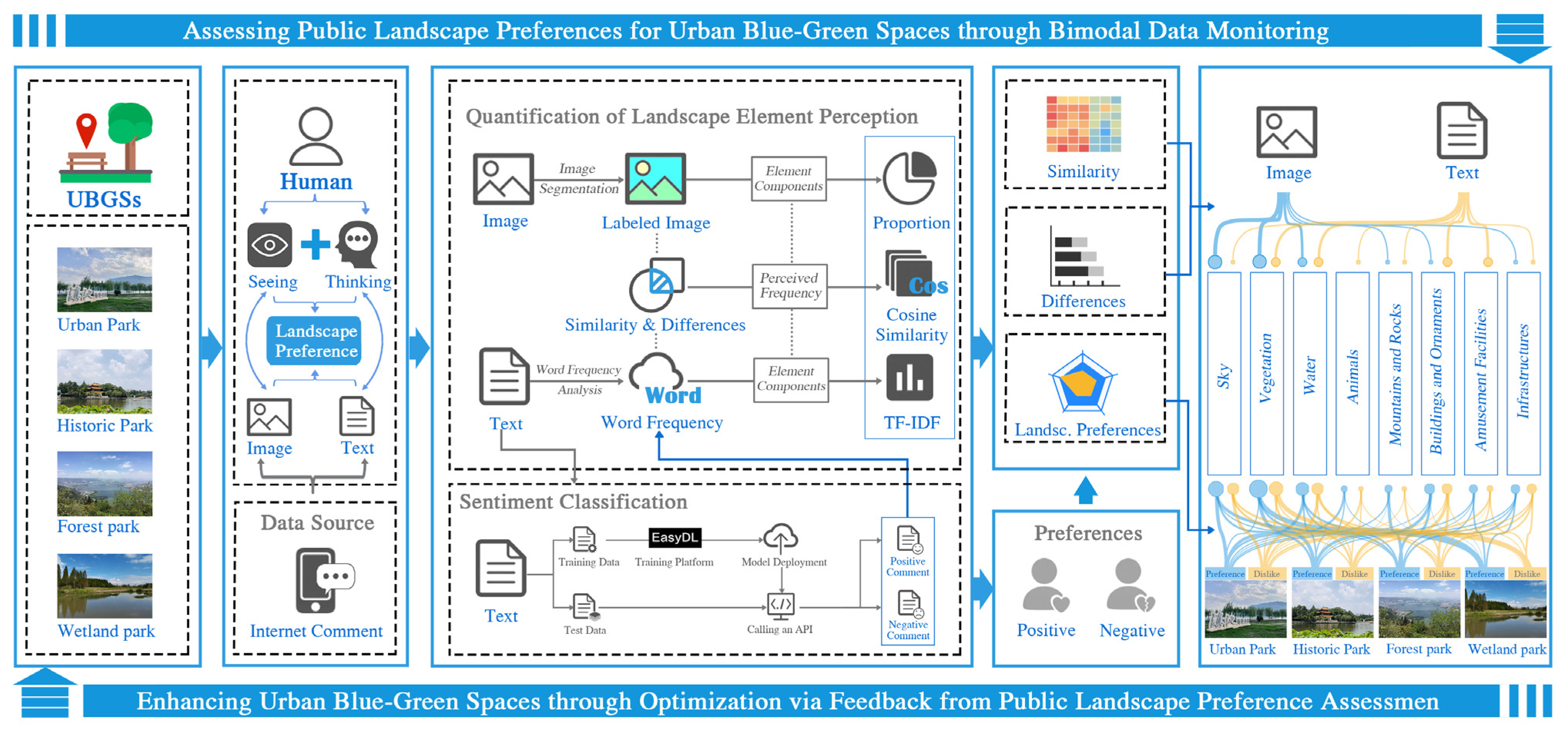
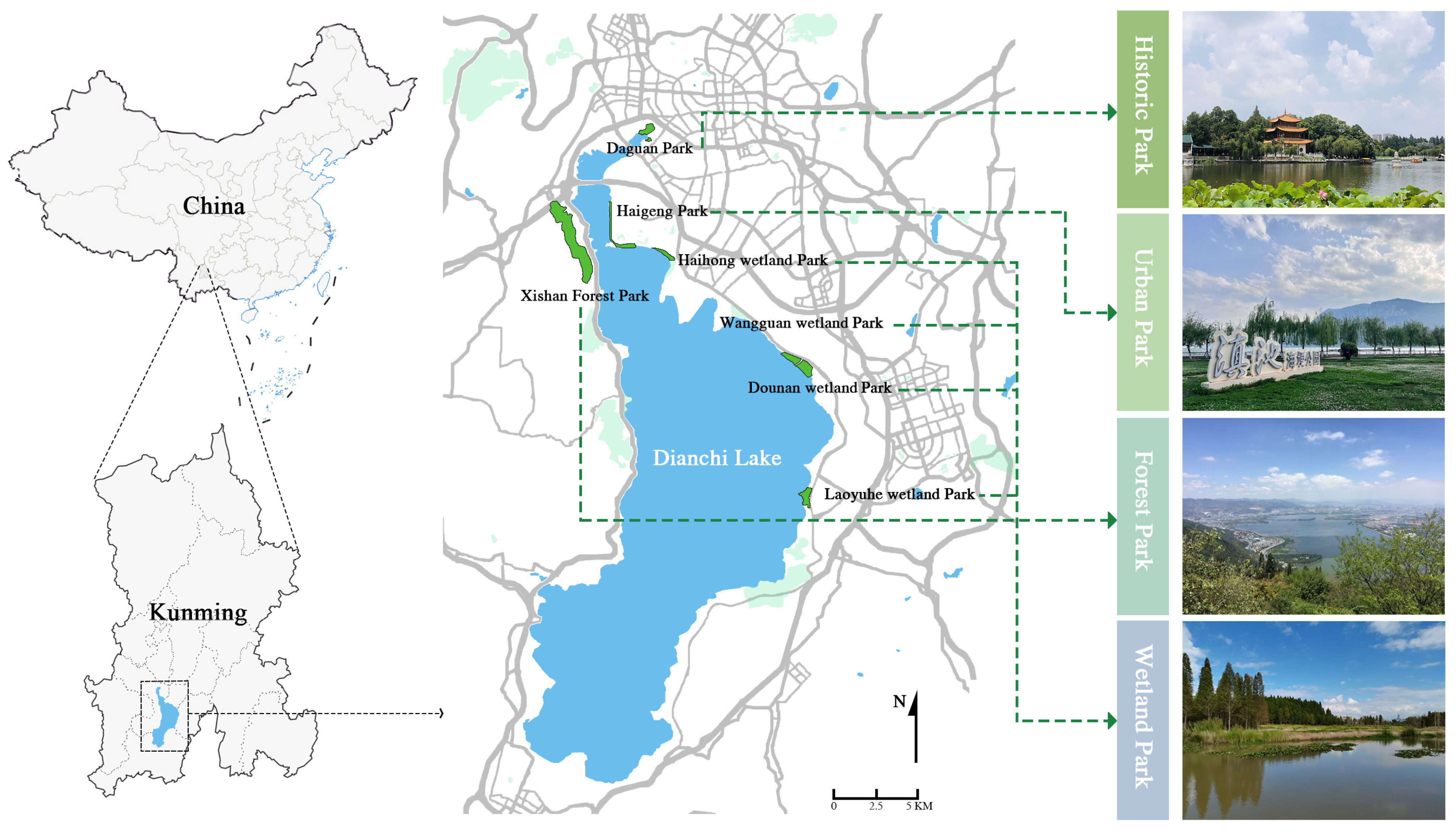

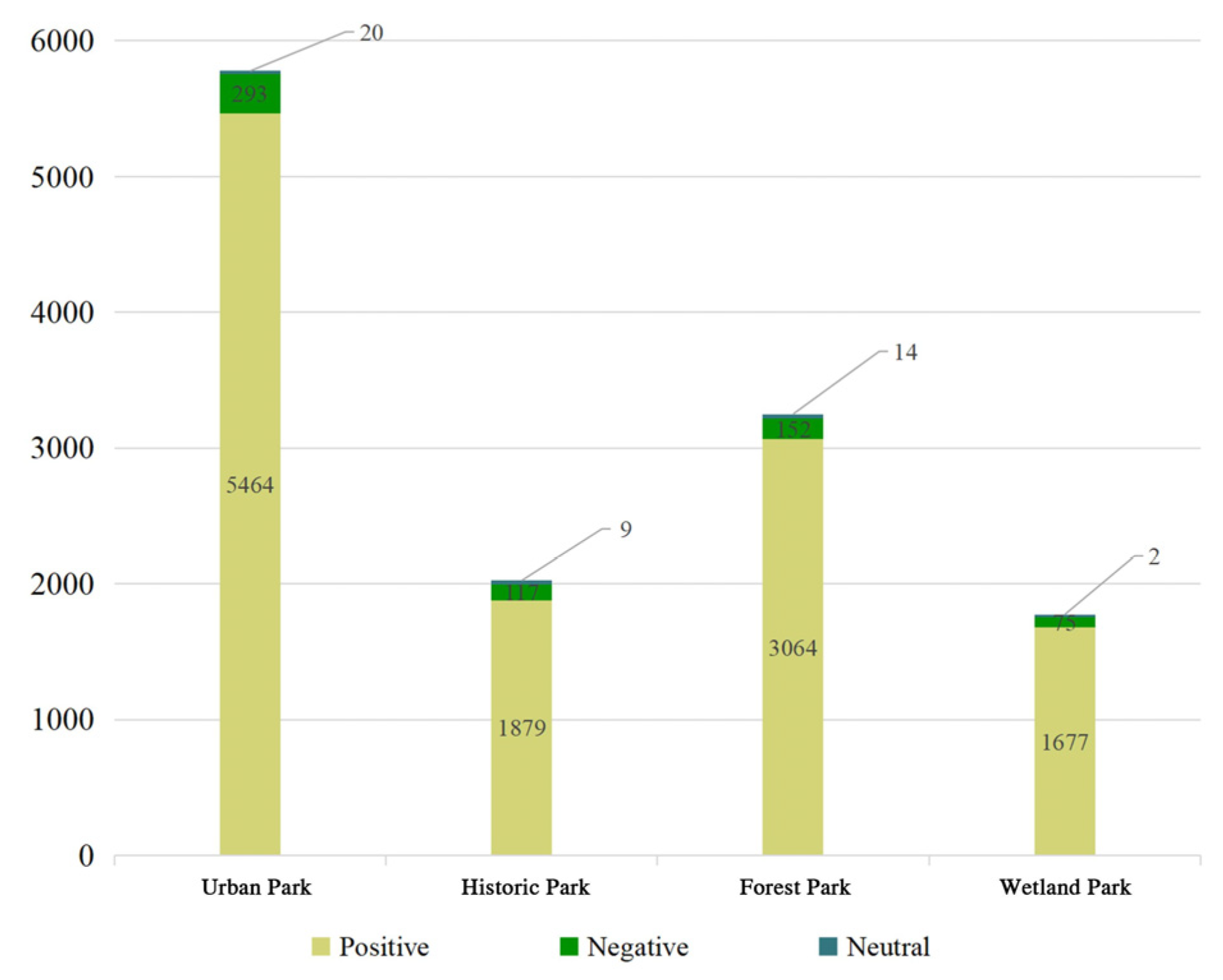

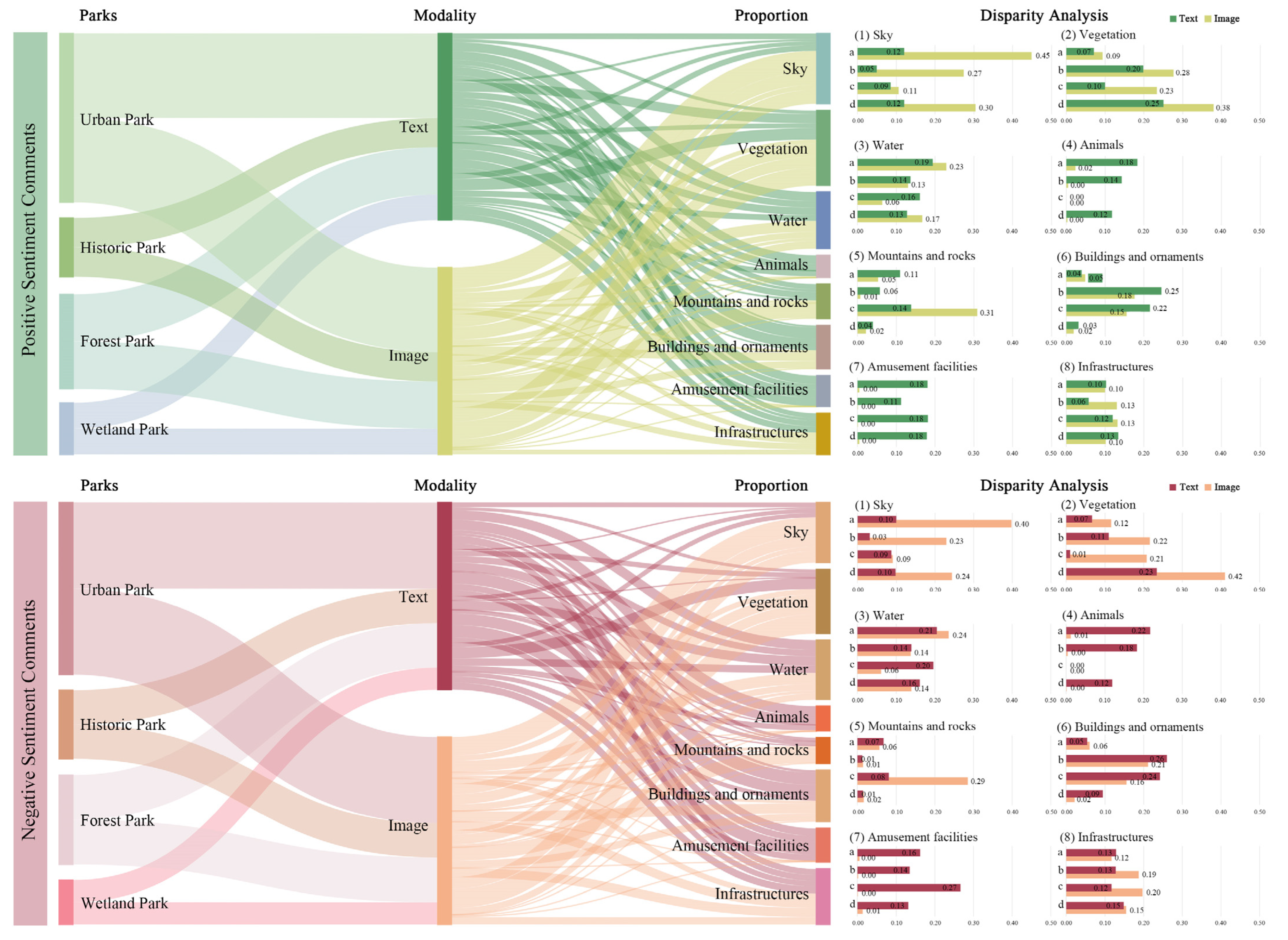
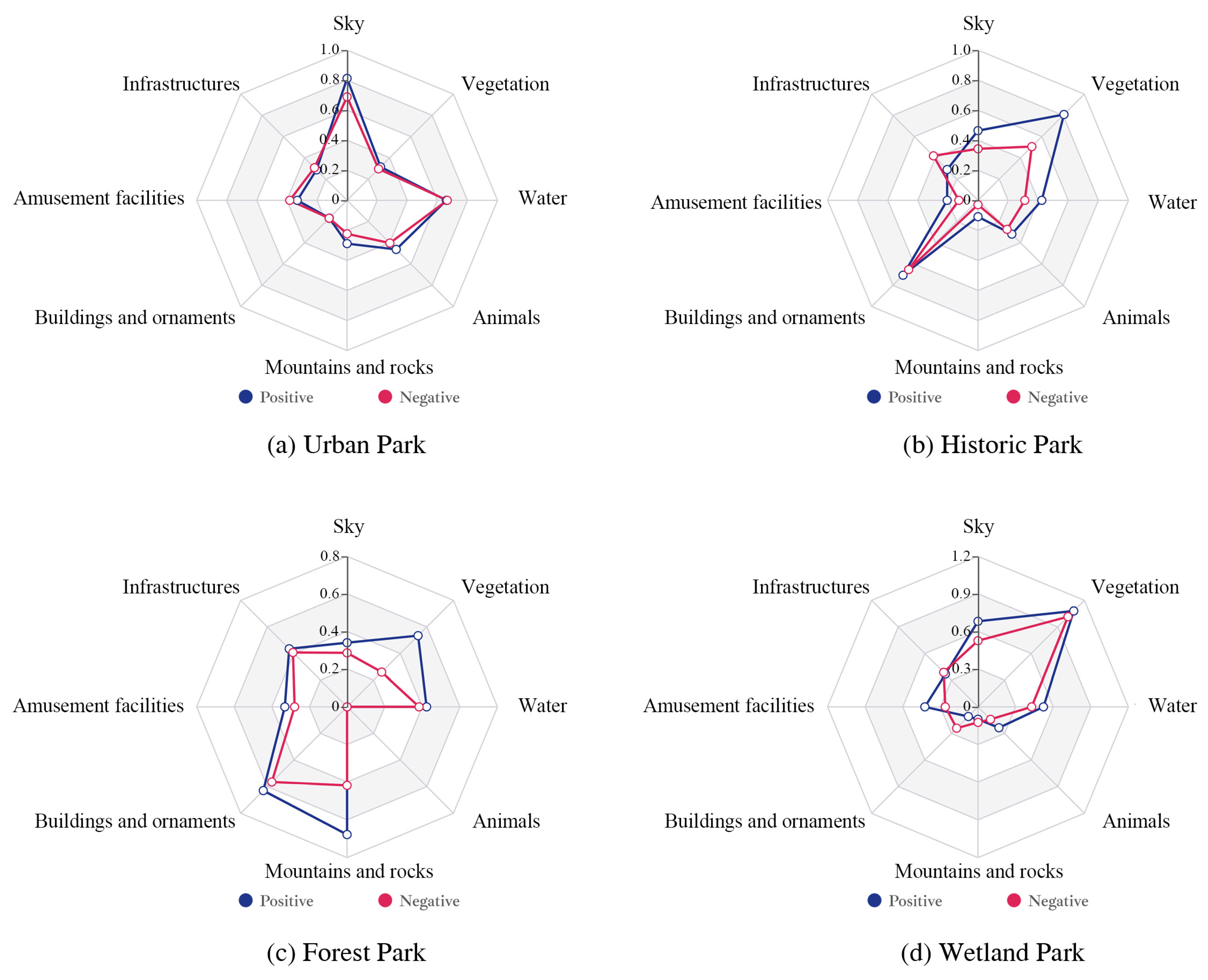
| Name | Area/ha | Type | Landscape Features |
|---|---|---|---|
| Dagauan Park | 46 | Historic park | The historic park is built along the water, with lake embankments, lotus ponds, and exquisite pavilions and terraces. The park, dating back to the Kangxi period, features the renowned Daguan Tower, from which people can enjoy views of Xishan mountain and Dianchi Lake. |
| Haigeng Park | 50 | Urban park | The urban park functions as the chief site for observing Dianchi Lake and Siberian seagulls. Along the lakefront, trees sway in shades of green, accompanied by orange and yellow paths, green lawns, and an array of vibrant sculptures, catering to people’s desires for leisure, physical activity, and social interaction. |
| Xishan Forest Park | 889 | Forest park | The Forest Park, adjacent to Dianchi Lake, boasts lush vegetation and a fresh and elegant environment. From this park, one can also have a panoramic view of the vast Dianchi Lake, making it an ideal destination for city residents to climb and enjoy the scenery. The numerous ancient temples and Qing Dynasty grottoes on the mountain are must-visit places for tourists who have a deep appreciation for cultural heritage. |
| Haihong Wetland Park | 26 | Wetland park | Wetland parks are situated around Dianchi Lake, serving ecological restoration and recreation purposes. The park encompasses waterborne forests, lawns, floral gardens, and natural-style revetments lining the waterfront, offering people opportunities to experience nature and participate in leisure activities. |
| Wangguan Wetland Park | 48 | ||
| Dounan Wetland Park | 43 | ||
| Laoyuhe Wetland Park | 53 |
| Precision | Recall | F1-Score | |
|---|---|---|---|
| Positive | 0.96 | 0.97 | 0.96 |
| Negative | 0.89 | 0.87 | 0.88 |
| Overall | 0.93 | 0.92 | 0.92 |
| Landscape Categories | Landscape Elements | Element Components |
|---|---|---|
| Natural landscapes | Sky | sky |
| Vegetation | trees | |
| grass | ||
| flowers | ||
| Water | water | |
| Animals | birds | |
| pets | ||
| Mountains and rocks | mountains | |
| rocks | ||
| Artificial landscapes | Buildings and ornaments | buildings |
| sculptures | ||
| lights | ||
| display boards | ||
| bridges | ||
| Amusement facilities | boats | |
| tents | ||
| grandstand | ||
| cable cars | ||
| Ferris wheels | ||
| bicycles | ||
| Infrastructures | barrier | |
| steps | ||
| roads | ||
| ground |
Disclaimer/Publisher’s Note: The statements, opinions and data contained in all publications are solely those of the individual author(s) and contributor(s) and not of MDPI and/or the editor(s). MDPI and/or the editor(s) disclaim responsibility for any injury to people or property resulting from any ideas, methods, instructions or products referred to in the content. |
© 2024 by the authors. Licensee MDPI, Basel, Switzerland. This article is an open access article distributed under the terms and conditions of the Creative Commons Attribution (CC BY) license (https://creativecommons.org/licenses/by/4.0/).
Share and Cite
Dao, C.; Qi, J. Seeing and Thinking about Urban Blue–Green Space: Monitoring Public Landscape Preferences Using Bimodal Data. Buildings 2024, 14, 1426. https://doi.org/10.3390/buildings14051426
Dao C, Qi J. Seeing and Thinking about Urban Blue–Green Space: Monitoring Public Landscape Preferences Using Bimodal Data. Buildings. 2024; 14(5):1426. https://doi.org/10.3390/buildings14051426
Chicago/Turabian StyleDao, Chenglong, and Jun Qi. 2024. "Seeing and Thinking about Urban Blue–Green Space: Monitoring Public Landscape Preferences Using Bimodal Data" Buildings 14, no. 5: 1426. https://doi.org/10.3390/buildings14051426
APA StyleDao, C., & Qi, J. (2024). Seeing and Thinking about Urban Blue–Green Space: Monitoring Public Landscape Preferences Using Bimodal Data. Buildings, 14(5), 1426. https://doi.org/10.3390/buildings14051426








